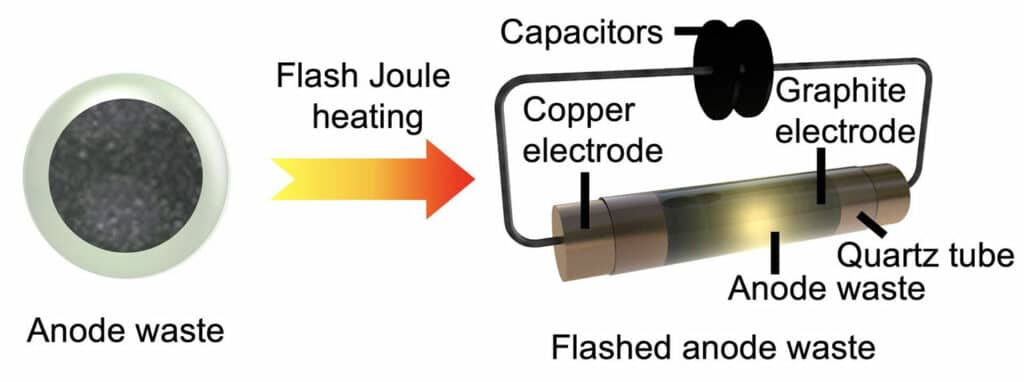The ever-increasing production of commercial lithium-ion batteries (LIBs) will result in a staggering accumulation of waste when they reach their end of life. A closed-loop solution, with effective recycling of spent LIBs, will lessen both the environmental impacts and economic costs of their use. Researchers said only about 5% of used lithium-ion batteries are currently recycled, and the regeneration of graphite anodes has, unfortunately, been mostly overlooked despite the considerable cost of battery-grade graphite.
Rice University researchers believe they have a partial solution that relies on the unique “flash” Joule heating process they developed to produce graphene from waste.
The Rice team has configured the process to quickly regenerate graphite anode materials found in lithium-ion batteries, removing impurities so they can be used again and again. Flashing powdered anodes from commercial batteries recycles some of the staggering accumulation of waste they currently leave behind. In just a few seconds, a jolt of high energy decomposes inorganic salts, including lithium, cobalt, nickel, and manganese, from an anode. These can be recovered by processing them with dilute hydrochloric acid.
“The production of lithium-ion batteries in 2026 is expected to be five times what it was in 2017, and right now, less than 5% of them are recycled,” Rice lab of chemist James Tour said. “That puts a heavy load on the environment, as these spent batteries are processed, and the anodes burned for energy or sent for landfills.”
“We’re claiming our process can recover critical metals and recondition anodes in a far more environmentally and economically friendly manner,” he continued.

The Rice lab reported that flashing anodes degrades the solid-electrolyte interphase (SEI), which conducts lithium ions but also insulates the anode from detrimental reactions. Flashing then costs the remaining graphite particles with an ion-permeable carbon shell that contributes to their future capacity, rate performance, and cycling stability compared to materials conventionally recycled in a time-consuming and energy-intensive process known as high-temperature calcination.
The lab estimated it would cost about $118 to recycle one ton of untreated anode waste. Researchers demonstrated that flash-recycled anodes have a recovered specific capacity of 351 milliamp hours per gram at 32 degrees Fahrenheit, superior to the rate performance and electrochemical stability of untreated or calcinated recycled anodes. When tested, the recycled, flashed anodes retained more than 77% of their capacity after 400 recharge cycles.
“Beyond the spent graphite anodes, we are confident that the cathodes, the electrolytes, and their mixtures can be effectively recycled or reconditioned by our method,” said Rice graduate student Weiyin Chen, lead author of the study.
Journal reference:
- Weiyin Chen, Rodrigo V. Salvatierra, John Tianci Li, Carter Kittrell, Jacob L. Beckham, Kevin M. Wyss, Nghi La, Paul E. Savas, Chang Ge, Paul A. Advincula, Phelecia Scotland, Lucas Eddy, Bing Deng, Zhe Yuan, James M. Tour. Flash Recycling of Graphite Anodes. Advanced material, 2022; DOI: 10.1002/adma.202207303
Fast ‘green’ process revives essential battery components for reuse
Source: Tambay News

0 Comments